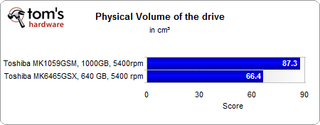9.5 Versus 12.5 mm: Which Notebook HDD Is Right For You?
Notebook drive manufacturers can choose between two drive heights: 9.5 mm and 12.5 mm. At 9.5 mm, most drives are limited to two spinning platters, while 12.5 mm has enough room for three, enabling higher capacity. We compare the two 2.5" variants.
Applications And Comparison
I've mentioned a few applications at which the three-platter drive might be superior. Laptops designed as desktop replacements typically require high storage capacities. Portable storage apps are increasingly important for backup purposes, as well as offloading your main storage away from a particular PC and to a more flexible location. Finally, an increasing number of consumer electronics and computing devices are trying to pack as much storage as possible into the smallest space for use in settings throughout the home.
We believe there's a market for entry-level, 2.5" server hard drives based on SATA and the taller z-height. Keep in mind that 3.5” drives conquered the high-capacity server space and the same could happen in the 2.5” world. Shifting to a 1TB capacity instead of the current 600GB maximum for SAS drives equals a 66% capacity increase. Knowing that a 1U rackmount server typically accomodates four 3.5” or ten 2.5” drives, the smaller form factor can offer significant capacity advantages.
Physical Drive Volumes

One terabyte versus 640GB equals a 56% capacity increase, and it comes with a 32% increase in required physical space.
Capacity per Volume and per Watt

We took the time to calculate a few additional numbers, such as capacity per volume in gigabytes per cm³. Clearly, the 2.5”, 12.5 mm drive offers almost 19% more storage capacity when in relation to the required physical space.

Knowing that performance is similar, we looked at the capacity per watt at streaming read operations, dividing total capacity by peak power consumption. Results would also be similar if we looked at capacity related to idle power.
Stay on the Cutting Edge
Join the experts who read Tom's Hardware for the inside track on enthusiast PC tech news — and have for over 25 years. We'll send breaking news and in-depth reviews of CPUs, GPUs, AI, maker hardware and more straight to your inbox.
Current page: Applications And Comparison
Prev Page 12.5 mm: MK1059GSM, 1,000GB Next Page Comparison Table And Test SetupMost Popular

